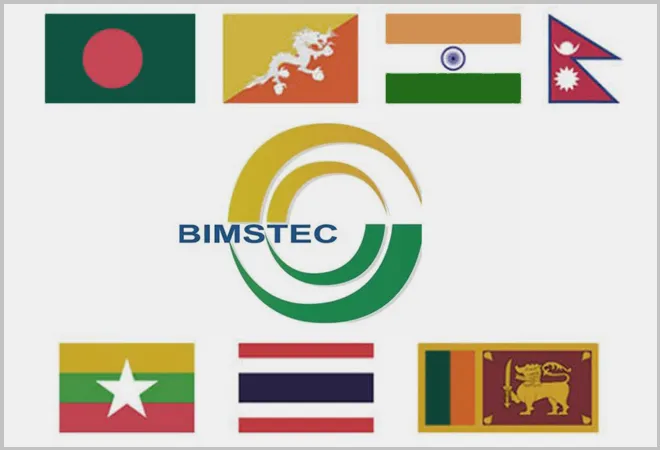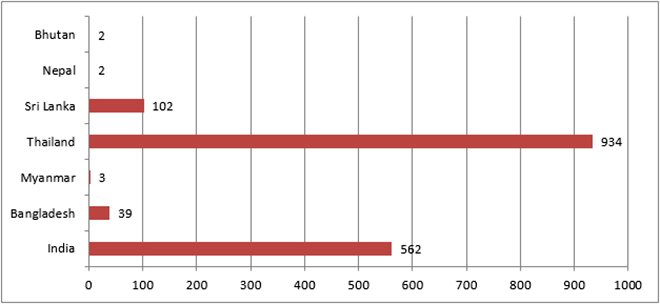
Conceived in 1997, the Bay of Bengal Initiative for Multi-Sectoral Technical and Economic Cooperation (BIMSTEC) is a grouping of 7 countries in South and South East Asia which includes India, Bangladesh, Sri Lanka, Myanmar, Thailand and the two landlocked countries of Nepal and Bhutan. In the 8th BIMSTEC ministerial meeting in Dhaka, 2005, Thailand proposed that the sector on traditional medicine (for facilitating efficient use of natural resources found in the member countries) should evolve into a comprehensive area of cooperation on 'Public Health', which is one of 14 sectors of cooperation under BIMSTEC at present. Until now there isn't much progress in this domain, but the outbreak of the Coronavirus pandemic brings to the fore how BIMSTEC needs to rise to the occasion in terms of advancing the ‘Public Health’ agenda in its future course of action. More importantly, the dependence of the BIMSTEC countries on the Chinese economy poses potential threats to containing COVID-19 in the near future. The following figure shows the COVID-19 positive cases in the BIMSTEC countries as of 25th March, 2020.
Figure: COVID-19 Positive Cases in the BIMSTEC Countries
 Source: World Health Organization
Source: World Health Organization
Apart from the strategic location of the BIMSTEC countries and abundance of social, physical, natural and human capital in the region, BIMSTEC had received a renewed vigor in recent times mainly on two fronts – the stagnation of SAARC which largely limited the scope for India's economic ambitions with Pakistan's stakes in it, alongside India's fears over the involvement of China in the almost annulled Bangladesh-China-India-Myanmar (BCIM) Economic Corridor. Secondly, India's non-participation in China's 'Belt and Road Initiative' makes it all the more important for India to strengthen its own strategic and economic ties in South Asia.
Despite India's regular attempts at keeping China out of its regional groupings for economic reasons (for example, India opting out of the Regional Comprehensive Economic Partnership last year), China is entrenched in almost all the economies of the world including the BIMSTEC countries. The following table, based on latest available data, depicts China's interconnectedness with the BIMSTEC countries. As China is the originating country for this global health disaster, these significant interlinkages are important to assess in current times when scientists across the world are predicting further outbreaks of COVID-19 in the future.
Table: BIMSTEC Countries' Economic Engagement with China
| BIMSTEC Countries/Groups |
China's Total Trade (2017) in Million USD |
Number of Persons Abroad (2017) in Chinese Contracted Projects & Labor Services |
Chinese FDI Utilized (2017) in Thousand USD |
| India |
84388 |
1444 |
157720 |
| Bangladesh |
16044 |
8197 |
100 |
| Myanmar |
13475 |
4682 |
1700 |
| Thailand |
80138 |
3405 |
110230 |
| Sri Lanka |
4398 |
4308 |
220 |
| Nepal |
985 |
1723 |
10 |
| Bhutan |
6 |
No Data |
No Data |
| BIMSTEC |
199434 |
23759 |
269980 |
| Asia |
2126525 |
667584 |
109193870 |
| BIMSTEC's Share in Asia |
9.38% |
3.56% |
0.25% |
| World |
4107164 |
979169 |
131035130 |
| BIMSTEC's Share in the World |
4.86% |
2.43% |
0.21% |
Source: Author's own using data from Chinese Statistical Yearbook 2018, National Bureau of Statistics of China.
Against this background the BIMSTEC countries need to pay heed to the following two aspects:
- For the last few decades the world has moved on to unprecedented paradigms of globalization with China playing a crucial part in the global value chains. There is no doubt that the world order and globalization patterns will be revised post this pandemic. There is a growing lack of faith in Chinese information in the public domain – from its steady economic growth data to Coronavirus updates. The fact that the Coronavirus emergency can re-appear from the thousands of infected Chinese citizens (the highest number of COVID-19 positive cases in the world as of now) makes it important for BIMSTEC to enhance its economic cooperation within the member states in order to contain China's dominance in the region.It is high time that countries will now start to find ways to become economically self-sufficient not only as a precautionary measure but also to cope up with the market confusion over Chinese business linkages. As the COVID-19 debacle could possibly end China's decade-long economic prowess, this disaster brings an opportunity for the developing Asian nations such as the BIMSTEC countries to effectively transform their business operations by substituting Chinese imports with efficient domestic production processes.
- In the field of ‘Public Health’, although traditional medicines are important in building immunity, the BIMSTEC countries need to broaden its horizon by enhancing healthcare infrastructure, operationalizing innovative technology and R&D, and importing medical know-how to counter infections such as COVID-19 which aren't conventional diseases and cannot be treated with traditional medication.Thailand is the lead country in the 'Public Health' area of cooperation within BIMSTEC and is doing an extraordinary job in handling this global pandemic. The country has the largest number of reported COVID-19 positive cases in the first few weeks, amongst all the BIMSTEC nations. The John Hopkins University ranked Thailand as Asia's most prepared country (6th globally, out of 165 countries) in dealing with an epidemic. Additionally, Thailand has also taken a range of fiscal and non-fiscal measures to protect the economy, especially its booming tourism sector which will be the worst hit. In fact, the WHO has praised Thailand's efforts in mitigating the current crisis and also for being the first country after China to report the virus. Hence, Thailand is expected to lead the way in the right direction in executing measures for an effective public health system within the BIMSTEC framework – one which is well equipped to handle such tensions in the future.
A new direction was added to India's foreign policy when the heads of the BIMSTEC states were invited to PM’s swearing-in ceremony for the second term in 2019 in contrast to the presence of SAARC leaders at the same ceremony during his first term in 2014. However, the PM’s turn towards SAARC in the middle of the Coronavirus emergency and India’s decision to contribute 10 million USD towards a ‘SAARC COVID-19 Emergency Fund’ depicts BIMSTEC's failure as an organization in preparing for such catastrophic situations, and more specifically, its lack of progress in the ‘Public Health’ sector which has a direct bearing on the economy and the well-being of the people in the region.
Africa and Asia are urbanizing faster than the other regions in the world and are projected to become 56% and 64% urban, respectively, by 2050 – many of these rapidly urbanizing cities are in the BIMSTEC countries. Increased globalization, connectivity and economic integration are set to drive the urbanization processes in these growing centres in Asia, which raises the vulnerability of these countries to human-borne diseases like this. Therefore, it is imperative for BIMSTEC to take the lead in this region in becoming economically independent to a certain extent and at the same time build a robust public health system to deal with future medical emergencies like the ongoing COVID-19 disaster.
The views expressed above belong to the author(s). ORF research and analyses now available on Telegram! Click here to access our curated content — blogs, longforms and interviews.




 Source:
Source:  PREV
PREV


